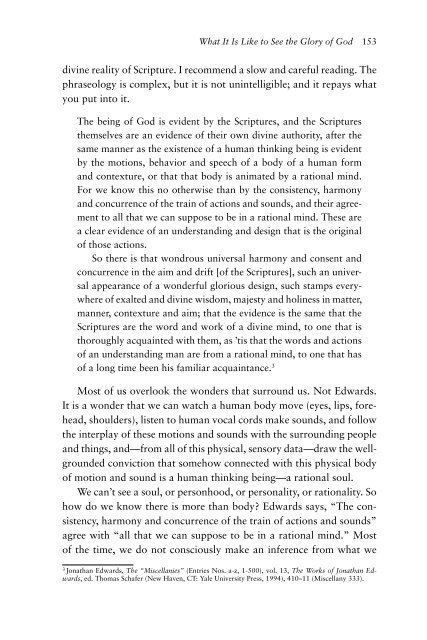Scriptures selfattesting authority question doctrine truthfulness Scriptures
peculiar-glory-en
peculiar-glory-en
Create successful ePaper yourself
Turn your PDF publications into a flip-book with our unique Google optimized e-Paper software.
What It Is Like to See the Glory of God 153<br />
divine reality of Scripture. I recommend a slow and careful reading. The<br />
phraseology is complex, but it is not unintelligible; and it repays what<br />
you put into it.<br />
The being of God is evident by the <strong>Scriptures</strong>, and the <strong>Scriptures</strong><br />
themselves are an evidence of their own divine <strong>authority</strong>, after the<br />
same manner as the existence of a human thinking being is evident<br />
by the motions, behavior and speech of a body of a human form<br />
and contexture, or that that body is animated by a rational mind.<br />
For we know this no otherwise than by the consistency, harmony<br />
and concurrence of the train of actions and sounds, and their agreement<br />
to all that we can suppose to be in a rational mind. These are<br />
a clear evidence of an understanding and design that is the original<br />
of those actions.<br />
So there is that wondrous universal harmony and consent and<br />
concurrence in the aim and drift [of the <strong>Scriptures</strong>], such an universal<br />
appearance of a wonderful glorious design, such stamps everywhere<br />
of exalted and divine wisdom, majesty and holiness in matter,<br />
manner, contexture and aim; that the evidence is the same that the<br />
<strong>Scriptures</strong> are the word and work of a divine mind, to one that is<br />
thoroughly acquainted with them, as ’tis that the words and actions<br />
of an understanding man are from a rational mind, to one that has<br />
of a long time been his familiar acquaintance. 3<br />
Most of us overlook the wonders that surround us. Not Edwards.<br />
It is a wonder that we can watch a human body move (eyes, lips, forehead,<br />
shoulders), listen to human vocal cords make sounds, and follow<br />
the interplay of these motions and sounds with the surrounding people<br />
and things, and—from all of this physical, sensory data—draw the wellgrounded<br />
conviction that somehow connected with this physical body<br />
of motion and sound is a human thinking being—a rational soul.<br />
We can’t see a soul, or personhood, or personality, or rationality. So<br />
how do we know there is more than body? Edwards says, “The consistency,<br />
harmony and concurrence of the train of actions and sounds”<br />
agree with “all that we can suppose to be in a rational mind.” Most<br />
of the time, we do not consciously make an inference from what we<br />
3<br />
Jonathan Edwards, The “Miscellanies” (Entries Nos. a-z, 1-500), vol. 13, The Works of Jonathan Edwards,<br />
ed. Thomas Schafer (New Haven, CT: Yale University Press, 1994), 410–11 (Miscellany 333).


